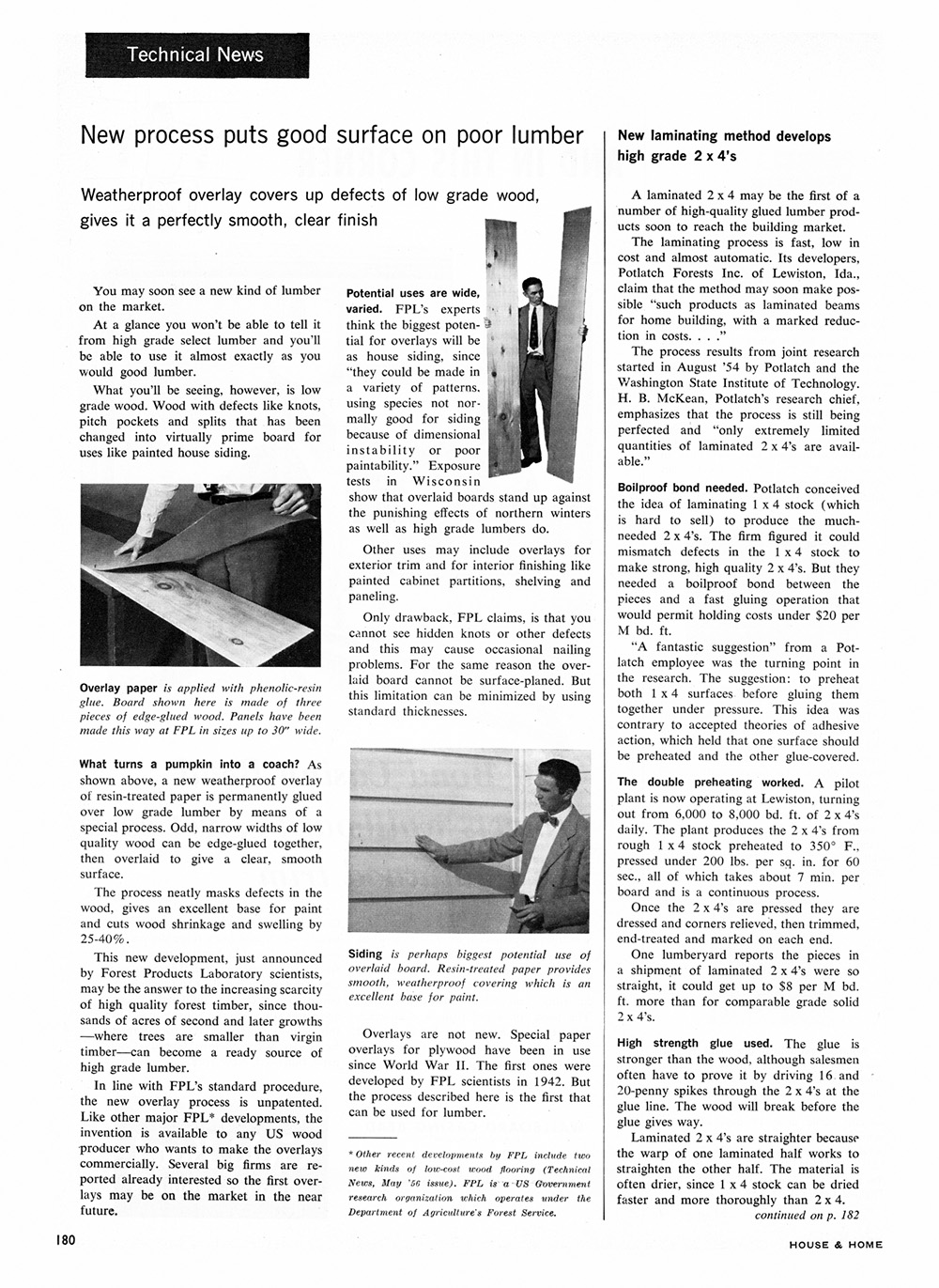


Technical News
New process puts good surface on poor lumber
Weatherproof overlay covers up defects of low grade wood, gives it a perfectly smooth, clear finish
You may soon see a new kind of lumber on the market.
At a glance you won't be able to tell it from high grade select lumber and you'll be able to use it almost exactly as you would good lumber.
What you'll be seeing, however, is low grade wood. Wood with defects like knots, pitch pockets and splits that has been changed into virtually prime board for uses like painted house siding.
Overlay paper is applied with phenolic-resin glue. Board shown here is made of three pieces of edge-glued wood. Panels have been made this way at FPL in sizes up to 30" wide.
Potential uses are wide, varied. FPL's experts think the biggest poten- â…ś tial for overlays will be as house siding, since "they could be made in a variety of patterns, using species not normally good for siding because of dimensional instability or poor paintability."ť Exposure tests in Wisconsin show that overlaid boards stand up against the punishing effects of northern winters as well as high grade lumbers do.
Other uses may include overlays for exterior trim and for interior finishing like painted cabinet partitions, shelving and paneling.
Only drawback, FPL claims, is that you cannot see hidden knots or other defects and this may cause occasional nailing problems. For the same reason the overlaid board cannot be surface-planed. But this limitation can be minimized by using standard thicknesses.
What turns a pumpkin into a coach? As
shown above, a new weatherproof overlay of resin-treated paper is permanently glued over low grade lumber by means of a special process. Odd, narrow widths of low quality wood can be edge-glued together, then overlaid to give a clear, smooth surface.
The process neatly masks defects in the wood, gives an excellent base for paint and cuts wood shrinkage and swelling by 25-40%.
This new development, just announced by Forest Products Laboratory scientists, may be the answer to the increasing scarcity of high quality forest timber, since thousands of acres of second and later growths where trees are smaller than virgin timber can become a ready source of high grade lumber.
In line with FPL's standard procedure, the new overlay process is unpatented. Like other major FPL* developments, the invention is available to any US wood producer who wants to make the overlays commercially. Several big firms are reported already interested so the first overlays may be on the market in the near future.
Siding is perhaps biggest potential use of overlaid board. Resin-treated paper provides smooth, weatherproof covering which is an excellent base for paint.
Overlays are not new. Special paper overlays for plywood have been in use since World War II. The first ones were developed by FPL scientists in 1942. But the process described here is the first that can be used for lumber.
* Other recent developments by FPL include two new kinds of low-cost wood flooring (Technical News, May '56 issue). FPL is a US Government research organization which operates under the Department of Agriculture's Forest Service.
New laminating method develops high grade 2 x 4's
A laminated 2x4 may be the first of a number of high-quality glued lumber products soon to reach the building market.
The laminating process is fast, low in cost and almost automatic. Its developers, Potlatch Forests Inc. of Lewiston, Ida., claim that the method may soon make possible "such products as laminated beams for home building, with a marked reduction in costs. . . ."ť
The process results from joint research started in August '54 by Potlatch and the Washington State Institute of Technology. H. B. McKean, Potlatch's research chief, emphasizes that the process is still being perfected and "only extremely limited quantities of laminated 2 x 4's are available."ť
Boilproof bond needed. Potlatch conceived the idea of laminating 1x4 stock (which is hard to sell) to produce the much-needed 2 x 4's. The firm figured it could mismatch defects in the 1x4 stock to make strong, high quality 2 x 4's. But they needed a boilproof bond between the pieces and a fast gluing operation that would permit holding costs under $20 per M bd. ft.
"A fantastic suggestion"ť from a Potlatch employee was the turning point in the research. The suggestion: to preheat both 1x4 surfaces before gluing them together under pressure. This idea was contrary to accepted theories of adhesive action, which held that one surface should be preheated and the other glue-covered.
The double preheating worked. A pilot plant is now operating at Lewiston, turning out from 6,000 to 8,000 bd. ft. of 2 x 4's daily. The plant produces the 2 x 4's from rough 1x4 stock preheated to 350° F., pressed under 200 lbs. per sq. in. for 60 sec., all of which takes about 7 min. per board and is a continuous process.
Once the 2 x 4's are pressed they are dressed and corners relieved, then trimmed, end-treated and marked on each end.
One lumberyard reports the pieces in a shipment of laminated 2 x 4's were so straight, it could get up to $8 per M bd. ft. more than for comparable grade solid 2 x 4's.
High strength glue used. The glue is stronger than the wood, although salesmen often have to prove it by driving 16 and 20-penny spikes through the 2 x 4's at the glue line. The wood will break before the glue gives way.
Laminated 2 x 4's are straighter because the warp of one laminated half works to straighten the other half. The material is often drier, since 1x4 stock can be dried faster and more thoroughly than 2x4.
continued on p. 182